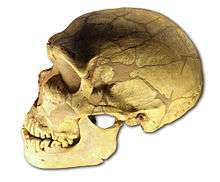La Ferrassie 1
 Mold of La Ferrassie 1 | |
| Catalog no. | La Ferrassie 1 |
|---|---|
| Species | Homo neanderthalensis |
| Age | 70–50,000 |
| Place discovered | La Ferrassie, France |
| Date discovered | 1909 |
| Discovered by | Capitan & Peyrony |
La Ferrassie 1 is a male Neanderthal skeleton estimated to be 70–50,000 years old. It was discovered at the La Ferrassie site in France by Louis Capitan and Denis Peyrony in 1909. The skull is the most complete Neanderthal skull ever found.[1] With a cranial capacity of 1641 cm3, it is the second largest hominid skull ever discovered, after Amud 1, another Neanderthal.
The skull displays many of the "classic" examples of Neanderthal anatomy, including a low, sloping forehead and large nasal openings. His leg and foot bones make it clear that Neanderthals walked upright like modern humans. The teeth are well preserved and the incisors are heavily worn down, suggesting they were used to hold objects.[1]
See also
- Dawn of Humanity (2015 PBS documentary)
- Human timeline
- Life timeline
- List of fossil sites (with link directory)
- List of Neanderthal fossils
- List of human evolution fossils (with images)
- Nature timeline
- Neanderthal
- Neanderthals of Gibraltar
- Origins of Us (2011 BBC documentary)
- Prehistoric Autopsy (2012 BBC documentary)
Notes
References
- "La Ferrassie". Smithsonian Institution's Human Origins Program. 2010. Retrieved 1 December 2012.
External links

- Human Timeline (Interactive) – Smithsonian, National Museum of Natural History (August 2016).
This article is issued from
Wikipedia.
The text is licensed under Creative Commons - Attribution - Sharealike.
Additional terms may apply for the media files.